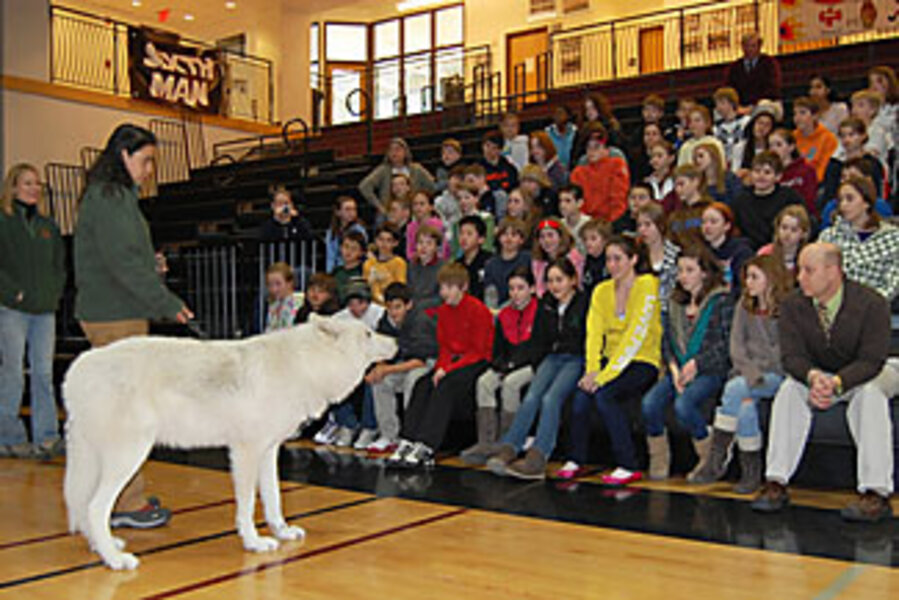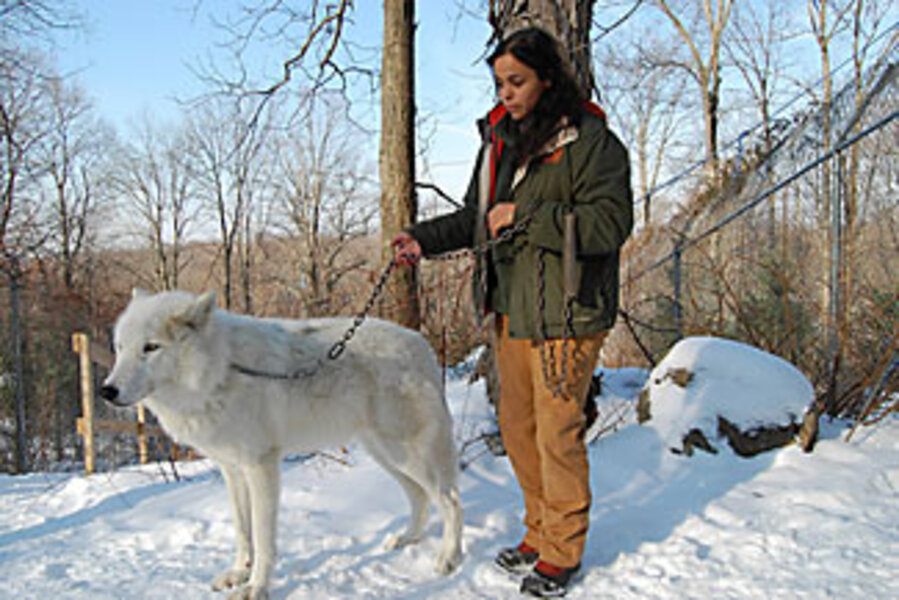For kids: On the road with Atka, the wolf
Loading...
| South Salem, N.Y.
I'm sitting in the back seat of a van next to a large, black, wire cage, the kind you might use to take a dog to the vet. The animal inside the cage isn't a dog, though. He's a 90-pound arctic wolf. He's as tall as a German shepherd, with a thick, white coat and bright yellow eyes.
A moment ago, the wolf looked at me and began licking the bars of the cage. So – even though I knew I shouldn't – I stuck my fingers into the cage.
Fortunately for me, this wolf has manners. He isn't biting my fingers. Instead, he's licking them.
Still, I wouldn't have considered doing this with any ordinary wolf. This wolf is special. His name is Atka and he is an ambassador wolf. Atka is one of four ambassador wolves who live at the Wolf Conservation Center in South Salem, N.Y. These wolves are called ambassadors because their job is to represent their species and to teach people about it. Atka differs from the other three ambassadors in one way: He visits many different places as part of his job. Today, I am going with Atka and two of his human handlers, Maggie Howell and Rebecca Bose, to St. Luke's School in New Canaan, Conn., where he will help teach a sixth-grade class about wolves and the environment.
While we drive and Atka watches the snowy fields roll past the window, Rebecca tells me about how he got such an unusual job.
"When we got him, Atka was 8 days old," she says. "He came from a facility in Minnesota where they breed wolves in captivity for zoos and or nature centers such as ours. From the very beginning, we worked with him with the thought that he might be able to go and do off-site programs. We took him to the post office and the bank and on various errands. We worked with him and the leash, getting into and out of vehicles, that sort of thing. He seemed to embrace this lifestyle – always curious and happy to go and see new things."
I ask Rebecca what other sorts of places Atka visits as part of his ambassadorial duties.
"Atka visits libraries, universities, festivals, scout meetings, museums, hospitals, and retirement homes," she answers. "He is a very unusual, special animal. We are blessed to have him."
When we arrive at the school, Atka waits outside with Rebecca while Maggie gives a presentation to the class, which has gathered in the gymnasium in front of a projector screen. "First, you're going to learn some stuff about wolves, and then you're going to meet our special friend, Atka," says Maggie. "So, how many of you think you might be scared of wolves?"
Several of the kids raise their hands. "That's OK," says Maggie.
She clicks the projector's remote, and a picture appears on the screen. It's a still from the Disney movie "Beauty and the Beast," and it shows the heroine, Belle, surrounded by a pack of fierce-looking wolves. "Many stories about wolves teach us to be scared of wolves," Maggie explains. "There are a lot of stories where wolves play the bad guy. But how many of you have dogs?" Several more kids raise their hands.
"If you have a dog, you live with the closest cousin of the wolf right in your house!" she says.
Maggie goes on to explain how wolves play an important role in the ecosystem. "Everything in nature has a job to do. In this ecosystem, wolves are what we call a keystone predator. That means that wolves affect every level of that ecosystem."
Without wolves, the system becomes unbalanced, says Maggie. Animals that would normally be food for the wolves, such as deer, are no longer hunted by humans and so their populations explode. Too many deer eat too many plants, and soon plant-eating bugs no longer have any food. That means the birds that eat those bugs no longer have any food, and so on, all the way around the food chain.
When the presentation is over, Rebecca brings Atka into the gymnasium on a long, sturdy leash. As soon as he appears, all the kids gasp. Atka doesn't seem to notice. He pads across the room calmly, occasionally raising his head to sniff the air. He makes his way to the bleachers. Atka pokes his nose into a jacket lying on a seat and wuffles around. Then he sticks his head under the bleachers. Not finding anything of interest, he pulls his head out and looks around some more. He moseys up and down the bleacher stairs.
While he walks, Maggie answers questions about wolves. That dark spot on the back of Atka's tail? It marks a scent gland that helps him mark his territory – which he sometimes does when he visits new places. What does Atka eat? Things like salmon and venison, with the occasional treat, such as bananas. (Later, Rebecca tells me, "We always try to give the wolves new things to enrich their lives – different types of fruits, vegetables, or spices. The banana was a huge hit.")
"It was so cool, Atka came right up next to me!" says Emma Crowley, a student, after the assembly.
"I thought Atka coming to school was really fun," says Perry Barringer. "He was walking all over the place. I wish he had marked his territory, though."
As we load Atka back into his cage in the van, Rebecca tells me that these trips are very important tools for teaching people about wolves.
"He is able to reach far more people by traveling," she says. "For example, some kids he sees are inner-city kids who would have a difficult time getting [to the nature center]. He helps us spread our word.
"Many people are affected in a positive way after seeing a wolf in person for the first time. He really drives our mission home with just his magnificent presence."






